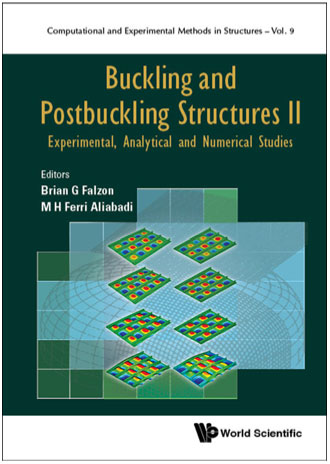
This book is Volume 9 of a series, edited by Professor Aliabadi, on computational and experimental methods in structures. Volume 1, with the same title, was published in 2008; the intervening titles have covered a wide range of topics. Five of the eight contributions deal with different aspects of the design of stiffened metal and composite panels for use in aircraft structures and their range of static and dynamic buckling phenomena; I shall review those chapters first.
Chapter 3, by Murphy and Quinn (Queen’s University Belfast) on the improvement of buckling and postbuckling behaviour in stiffened aircraft panels, is a coherent and clearly presented experimental and computational study. Physical specimens are machined from solid aluminium. ‘Classical’ design schemes are investigated and finite-element computations on imperfection sensitivity are performed. Different layouts of ribs are investigated in order to improve the buckling performance for a given mass.
Chapter 5, by Jansen and Rolfes (Leibniz Universitat Hannover) and Rahman (DIANA FEA BV, Delft), on the computational analysis of static and dynamic buckling and mode-coupling phenomena in composite panels and cylindrical shells under compression, uses a reduced-order modal-based finite-element scheme inspired by the work of Koiter and Budiansky. The advantages of the scheme, over ‘raw’ finite element (FE) methods for imperfection-sensitive structures under static and dynamic loading, are manifest in two specific examples.
Chapter 6, by Vescovini (Politecnico di Milano) and Bisagni (Delft University of | Technology), describes the analysis of composite, stiffened panels using a semi-analytical Ritz-energy approach. Examples of typical aeronautical panels with two different types of stiffener demonstrate the computationally efficient capture of local skin and stiffener instabilities and mode-jumping phenomena that have been reported in the literature on experimental studies.
Chapter 7, by Bacarreza and Aliabadi (Imperial College London), addresses the problem of optimisation in the design of stiffened composite panels in compression. The text incorporates a plethora of acronyms. Half of the chapter consists of a survey of optimisation methods; the remainder describes a specific example that involves a number of arbitrary assumptions.
Chapter 8, by Faggiani (Imperial College London) and Falzon (Queen’s University Belfast), is a clearly written and jargon-free account of optimisation of thin-skinned composite panels, with special attention to the phenomenon whereby the energy-release in mode jumping can initiate the debonding of stiffeners. Careful nonlinear computations model closely the output of LVDTs on experimental panels under compression.
Chapter 1, by Croll (University College London), describes the author’s ‘reduced stiffness method’ for prediction of lower-bound buckling loads for many classes of shell geometry, subjected to a variety of loading. The crux of the method is presented in the form of three general lemmas and several corollaries, expressed in a species of technical language. It is claimed that of all possible buckling modes, the one associated with the lowest classical critical load generally provides the controlling reduced-stiffness lower bound to experimental buckling loads. The argument is supported by a range of specific examples.
Chapter 2, by Shamass (South Bank University, London), Alfano (Brunel University) and Guarracino (University of Naples), investigates the ‘plastic buckling paradox’ in the buckling of metal cylinders. Presenting a general survey of the field, it tends to provide insufficient detail in descriptions of previous work. Some diagrams are misleading: e.g. Fig. 9 on Hutchinson’s (1972) model is muddled; and Fig. 10 embodies a serious category error. The work makes no advance on Hutchinson’s definitive 1974 paper, which is not referenced.
Chapter 4, by Blachut (AGH University of Science and Technology, Kraków), considers the use of composites in underwater pressure-hull components. Mainly a digest of 25 previously published papers by the author, it contains many detailed graphical plots, of which some have unhappily laconic captions.


